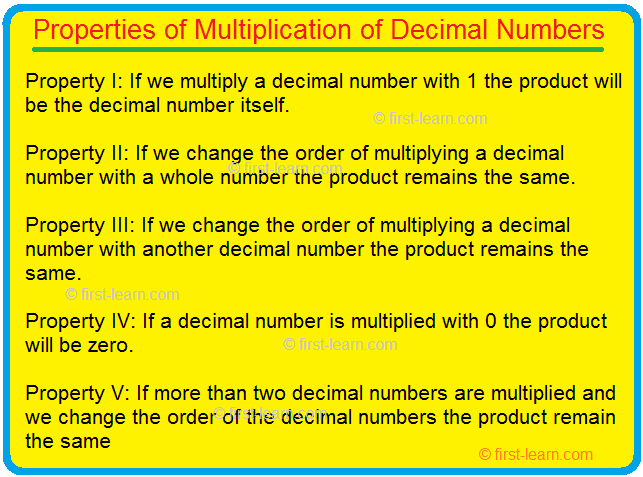Properties of Multiplication of Decimal Numbers
This topic will deal with properties of multiplication of decimal numbers. These properties on multiplication of decimal numbers will help the learners to understand better. It will give them a different and unique insight into this topic of multiplication of decimal numbers. The properties on multiplication of decimal numbers will enrich their knowledge on this topic and thereby boost better understanding. Five very basic properties of multiplication of decimal numbers would help the learners in understanding the concept better along with few examples on each of the property discussed.
Here in this content we will discuss the properties on multiplication of decimal numbers:
Property I: If we multiply a decimal number with 1 the product will be the decimal number itself.
Here are few examples to illustrate the property:
Examples:
(i) 56.258 × 1 = 56.258
(ii) 784.244 × 1 = 784.244
(iii) 8850.45 × 1 = 8850.45
(iv) 15.06 × 1 = 15.06
(v) 19.743 × 1 = 19.743
Property II: If we change the order of multiplying a decimal number with a whole number the product remains the same.
Here are few examples to illustrate the property:
Examples:
(i) 23.52 × 11 = 11 × 23.52 = 258.72
(ii) 140.21 × 21 = 21 × 140.21 = 2944.41
(iii) 46. 12 × 6 = 6 × 46.12 = 276.72
(iv) 115.88 × 42 = 42 × 115.88 = 4866.96
(v) 59.10 × 16 = 16 × 59.10 = 945.60
Property III: If we change the order of multiplying a decimal number with another decimal number the product remains the same.
Here are few examples to illustrate the property:
Examples:
i) 78.74 × 54.21 = 54.21 × 78.74 = 426.4954
ii) 0.01 × 2.21 = 2.21 × 0.01 = 0.0221
iii) 25.14 × 3.2 = 3.2 × 25.14 = 80.448
iv) 14.96 × 7.8 = 7.8 × 14.96 = 116.88
v) 12.30 × 1.5 = 1.5 × 12.30 = 18.45
Property IV: If a decimal number is multiplied with 0 the product will be zero.
Here are few examples to illustrate the property:
Examples:
(i) 7.54 × 0 = 0
(ii) 19.86 × 0 = 0
(iii) 132.54 × 0 = 0
(iv) 44.13 × 0 = 0
(v) 112.25 × 0 = 0
Property V: If more than two decimal numbers are multiplied and we change the order of the decimal numbers the product remain the same.
Here are few examples to illustrate the property:
Examples:
(i) 25.26 × (1.4 × 2.3)
= 25.26 × 3.22
= 81.3372
On changing their grouping order of multiplication.
(1.4 × 25.26) × 2.3
= 35.364 × 2.3
= 81.3372
So we can see the on changing the order of grouping the product does not change.
(ii) 3.62 × (0.5 × 8.7)
= 3.62 × 4.35
= 15.747
On changing their grouping order of multiplication.
(8.7 × 3.62) × 0.5
= 31.494 × 0.5
= 15.747
So we can see the on changing the order of grouping the product does not change.
From Properties of Multiplication of Decimal Numbers to HOME PAGE
Recent Articles
-
What Is Plasma? | Blood Plasma | Proteins | Nutrients | Cholesterol
Nov 07, 25 10:29 AM
Blood is a mobile fluid which is a connective tissue and is derived from the mesoderm like cell any other connective tissue. Colour of blood is reddish and that flows inside the blood vessels by means… -
Disorders of Respiratory System | Tuberculosis | Pleurisy | Emphysema
Oct 28, 25 11:39 PM
Tuberculosis is very common disease and is caused by a type of bacteria called Mycobacterium tuberculosis. This disease causes different trouble in the respiration and infection of several parts of th… -
Regulation of Respiration | Respiratory Centres | Inspiratory Area |
Oct 14, 25 12:13 AM
Respiratory Centre is the area that controls the rate of respiration and it is observed to be located in medulla oblongata and pons. Respiratory Centre has the following will dispersed components like… -
Explain Transport of Gases | External Respiration | Tissue Respiration
Oct 09, 25 11:35 PM
In humans gaseous exchange is completed in the following ways the steps are - External Respiration or Breathing - Breathing in false taking in of Oxygen and giving out of carbon dioxide in the body. M… -
Kind and Number of Teeth | Location of Teeth in Mouth | Care of Teeth
Sep 11, 25 12:52 AM
Kind and Number of Teeth






New! Comments
Have your say about what you just read! Leave me a comment in the box below.